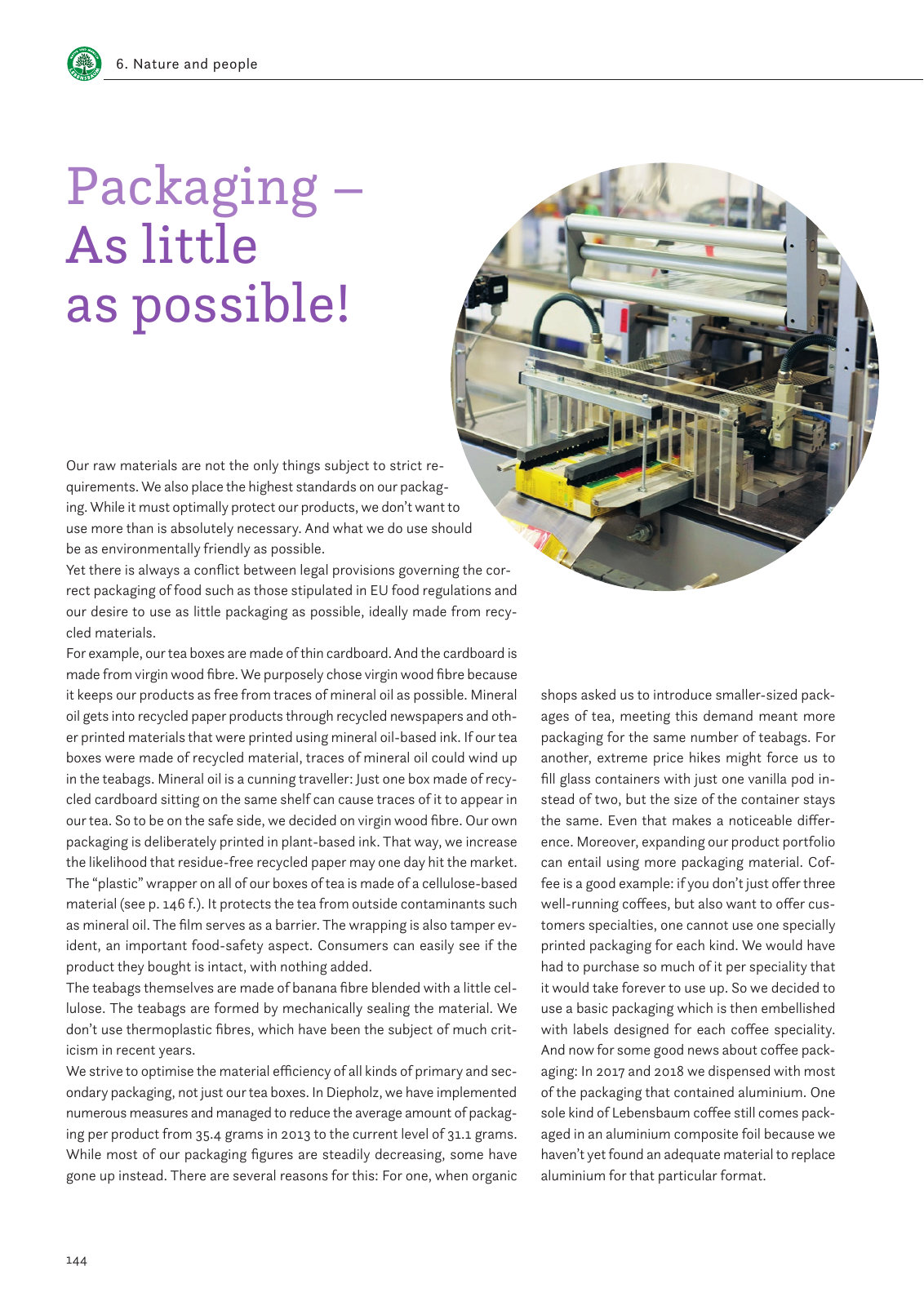144 Packaging As little as possible Our raw materials are not the only things subject to strict re quirements We also place the highest standards on our packag ing While it must optimally protect our products we don t want to use more than is absolutely necessary And what we do use should be as environmentally friendly as possible Yet there is always a conflict between legal provisions governing the cor rect packaging of food such as those stipulated in EU food regulations and our desire to use as little packaging as possible ideally made from recy cled materials For example our tea boxes are made of thin cardboard And the cardboard is made from virgin wood fibre We purposely chose virgin wood fibre because it keeps our products as free from traces of mineral oil as possible Mineral oil gets into recycled paper products through recycled newspapers and oth er printed materials that were printed using mineral oil based ink If our tea boxes were made of recycled material traces of mineral oil could wind up in the teabags Mineral oil is a cunning traveller Just one box made of recy cled cardboard sitting on the same shelf can cause traces of it to appear in our tea So to be on the safe side we decided on virgin wood fibre Our own packaging is deliberately printed in plant based ink That way we increase the likelihood that residue free recycled paper may one day hit the market The plastic wrapper on all of our boxes of tea is made of a cellulose based material see p 146 f It protects the tea from outside contaminants such as mineral oil The film serves as a barrier The wrapping is also tamper ev ident an important food safety aspect Consumers can easily see if the product they bought is intact with nothing added The teabags themselves are made of banana fibre blended with a little cel lulose The teabags are formed by mechanically sealing the material We don t use thermoplastic fibres which have been the subject of much crit icism in recent years We strive to optimise the material efficiency of all kinds of primary and sec ondary packaging not just our tea boxes In Diepholz we have implemented numerous measures and managed to reduce the average amount of packag ing per product from 35 4 grams in 2013 to the current level of 31 1 grams While most of our packaging figures are steadily decreasing some have gone up instead There are several reasons for this For one when organic shops asked us to introduce smaller sized pack ages of tea meeting this demand meant more packaging for the same number of teabags For another extreme price hikes might force us to fill glass containers with just one vanilla pod in stead of two but the size of the container stays the same Even that makes a noticeable differ ence Moreover expanding our product portfolio can entail using more packaging material Cof fee is a good example if you don t just offer three well running coffees but also want to offer cus tomers specialties one cannot use one specially printed packaging for each kind We would have had to purchase so much of it per speciality that it would take forever to use up So we decided to use a basic packaging which is then embellished with labels designed for each coffee speciality And now for some good news about coffee pack aging In 2017 and 2018 we dispensed with most of the packaging that contained aluminium One sole kind of Lebensbaum coffee still comes pack aged in an aluminium composite foil because we haven t yet found an adequate material to replace aluminium for that particular format 6 Nature and people

Hinweis: Dies ist eine maschinenlesbare No-Flash Ansicht.
Klicken Sie hier um zur Online-Version zu gelangen.
Klicken Sie hier um zur Online-Version zu gelangen.